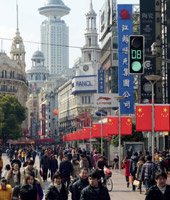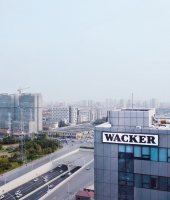WACKER Stock in 2013
A wide range of factors influenced the performance of WACKER stock in 2013. The chief factor was the progress of the EU’s trade dispute with China over punitive tariffs for Chinese solar modules. The agreement between the EU Commission and the Chinese Ministry of Commerce in late July had a very positive impact on WACKER’s share price. Capital markets also responded positively to WACKER’s first publication of medium-term goals through to 2017. The Executive Board presented the goals and the strategy for achieving them at a dedicated conference for analysts and investors in London on July 1, 2013.
Trade Dispute Between the EU and China Affects WACKER’s Share Price
In Q1 2013, German and international capital markets were essentially dominated by fiscal-policy developments in Europe and the USA. Although there was a growing consensus that the acute symptoms of the crisis were subsiding in the European Monetary Union, both the struggle to avert impending sovereign default in Cyprus and Italy’s ongoing political instability rekindled market participants’ fears. In the USA, Congress and the Administration were unable to find a consensus on ways to reduce the US budget deficit. As a result, a so-called sequester took effect in early March, resulting in a drastic reduction in federal spending.
During the first quarter, WACKER stock, at times, clearly outperformed the DAX and MDAX. It started at € 49.65 (year-end closing price on Dec. 28, 2012). The share price received impetus from positive market reports on the growth outlook for photovoltaics in non-European economies and from the ending of short-time work at WACKER POLYSILICON in February 2013. As a result, the stock climbed to € 70.38 (Feb. 25, 2013), though it declined again afterward and ended the first quarter at € 55.83 (closing price on March 28, 2013).
The release of WACKER’s preliminary 2012 figures on February 7, 2013, and the publication of the annual report on March 14, 2013, did not affect the price of WACKER stock.
During the second quarter of 2013, there were increasing signs that the global economy would stabilize and that the European Central Bank would continue its policy of low interest rates. Both these factors calmed stock markets for a time, but did not remove the skepticism of market participants in the long term. Additionally, economic trends diverged strongly across the individual regions. While the US economy continued on its path to recovery, growth in China slowed. The eurozone remained in recession. And the crisis-hit countries of southern Europe saw the financial and economic crisis continue unabated.
WACKER’s stock started the second quarter at € 55.85 (closing price on April 2, 2013) and shortly afterward fell to its year-low of € 50.66 (April 18, 2013). From mid-April, it moved within a corridor of € 50 to € 60. The uncertainties of the solar dispute between the European Union and China were seen in the share price. In early June, the European Union imposed provisional import tariffs on Chinese solar products. At the end of the quarter, WACKER stock was quoted at € 57.82 (June 28, 2013).
The publication of WACKER’s first-quarter report on April 30, 2013 and the Annual Shareholders’ Meeting of May 8, 2013 had no immediately noticeable impact on the share price.
From July through September 2013, global financial markets saw bright spells and cloudy periods. Europe’s financial and sovereign-debt crisis became somewhat less acute in the eyes of many market participants. Moreover, the US Federal Reserve and European Central Bank decided to adhere to their low-interest-rate policies for the time being. Both these aspects helped provide some relief for stock markets. On the other hand, conflicts in Arab countries such as Syria and Egypt intensified the risks to the world economy. The long-running dispute over the US budget also affected capital markets.
At the start of the third quarter, WACKER’s share price was € 58.95. In the following weeks, positive news about the resolved solar dispute between Europe and China significantly buoyed the share price, which rose to € 78.92 (Aug. 23, 2013) – a level last reached in early 2012. For the rest of the quarter, it tended to move sideways at over € 70. WACKER stock closed September at € 72.95.
In the fourth quarter, too, financial markets were subject to fluctuating influences. The European Central Bank’s surprise decision to cut the base rate to its lowest-ever level since the ECB’s creation lifted European stock markets in early November. The ECB had set the base rate at 0.25 percent. Conversely, speculation about the US Federal Reserve scaling back its bond-buying program in response to an improving economy adversely affected capital markets. The European financial and sovereign-debt crisis did not play a major role in that quarter. The weakness of global economic growth and the usual seasonal effects at our chemical divisions amid slower construction-product demand during the winter months impacted WACKER’s business again last year. On December 6, representatives of the EU member states agreed in Brussels to extend the EU’s punitive tariffs on Chinese solar products by two years. Conversely, a negative impact resulted from the controversy about whether to exempt energy-intensive companies from the EEG levy and from power-grid charges. The agreement reached in the US budget dispute and the welcome news that the US Federal Reserve intended to somewhat tighten its ultra-easy monetary policy stimulated stock-market activity. WACKER’s share price benefited from positive signals about photovoltaic-sector growth.
WACKER stock entered the final quarter at € 75.00 (closing price on Oct. 1, 2013), but then lost a little ground. This was due to the publication of the Q3 figures on October 31, 2013. Capital markets had expected earnings in particular to be higher. The share price fell back briefly to € 65.00 (Nov. 4, 2013). A renewed upturn was prompted by positive signals from the solar market due to high demand and by the trade-dispute settlement. WACKER stock climbed to € 80.10 on December 2, 2013, crossing the € 80 threshold for the first time since 2011. It reached its high of € 82.01 on December 27, 2013. Performing notably better than either the DAX or MDAX, the stock closed at € 80.38 on December 30, 2013.




